battery location NISSAN LEAF 2020 Owner´s Manual
[x] Cancel search | Manufacturer: NISSAN, Model Year: 2020, Model line: LEAF, Model: NISSAN LEAF 2020Pages: 596, PDF Size: 4.33 MB
Page 24 of 596
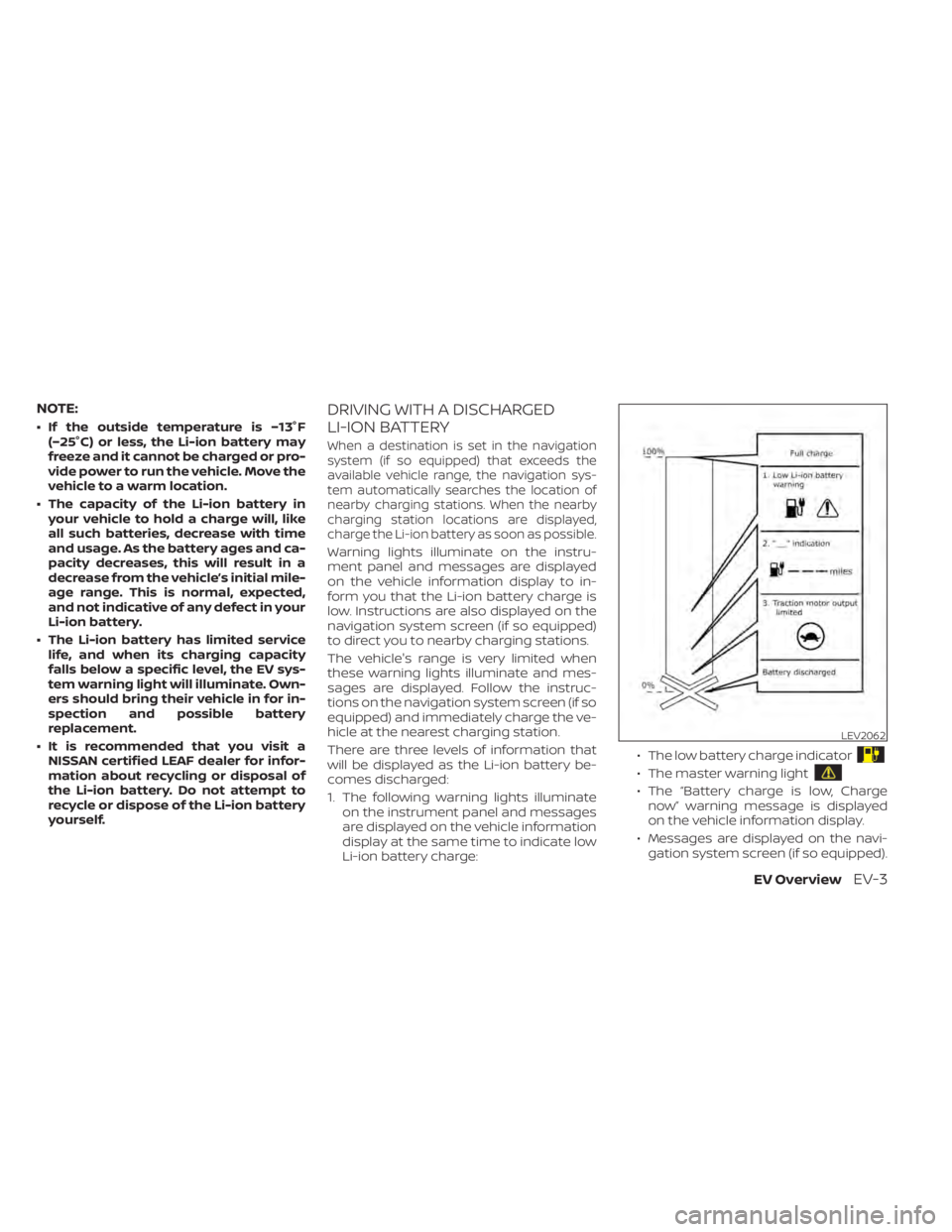
NOTE:
• If the outside temperature is −13°F(−25°C) or less, the Li-ion battery may
freeze and it cannot be charged or pro-
vide power to run the vehicle. Move the
vehicle to a warm location.
• The capacity of the Li-ion battery in your vehicle to hold a charge will, like
all such batteries, decrease with time
and usage. As the battery ages and ca-
pacity decreases, this will result in a
decrease from the vehicle’s initial mile-
age range. This is normal, expected,
and not indicative of any defect in your
Li-ion battery.
• The Li-ion battery has limited service life, and when its charging capacity
falls below a specific level, the EV sys-
tem warning light will illuminate. Own-
ers should bring their vehicle in for in-
spection and possible battery
replacement.
• It is recommended that you visit a NISSAN certified LEAF dealer for infor-
mation about recycling or disposal of
the Li-ion battery. Do not attempt to
recycle or dispose of the Li-ion battery
yourself.
DRIVING WITH A DISCHARGED
LI-ION BATTERY
When a destination is set in the navigation
system (if so equipped) that exceeds the
available vehicle range, the navigation sys-
tem automatically searches the location of
nearby charging stations. When the nearby
charging station locations are displayed,
charge the Li-ion battery as soon as possible.
Warning lights illuminate on the instru-
ment panel and messages are displayed
on the vehicle information display to in-
form you that the Li-ion battery charge is
low. Instructions are also displayed on the
navigation system screen (if so equipped)
to direct you to nearby charging stations.
The vehicle's range is very limited when
these warning lights illuminate and mes-
sages are displayed. Follow the instruc-
tions on the navigation system screen (if so
equipped) and immediately charge the ve-
hicle at the nearest charging station.
There are three levels of information that
will be displayed as the Li-ion battery be-
comes discharged:
1. The following warning lights illuminate on the instrument panel and messages
are displayed on the vehicle information
display at the same time to indicate low
Li-ion battery charge: • The low battery charge indicator
• The master warning light
• The “Battery charge is low, Charge
now” warning message is displayed
on the vehicle information display.
• Messages are displayed on the navi- gation system screen (if so equipped).
LEV2062
EV OverviewEV-3
Page 26 of 596
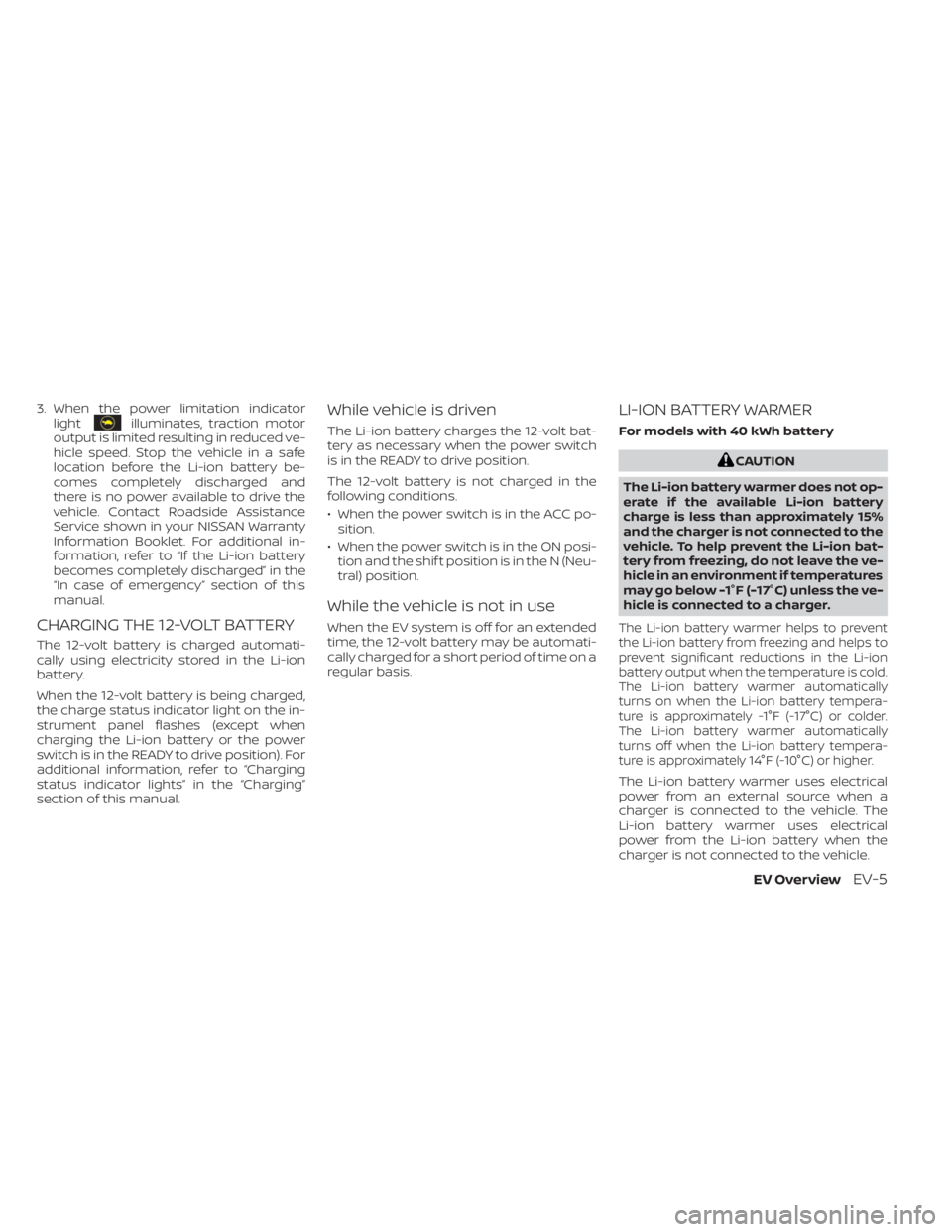
3. When the power limitation indicatorlightilluminates, traction motor
output is limited resulting in reduced ve-
hicle speed. Stop the vehicle in a safe
location before the Li-ion battery be-
comes completely discharged and
there is no power available to drive the
vehicle. Contact Roadside Assistance
Service shown in your NISSAN Warranty
Information Booklet. For additional in-
formation, refer to “If the Li-ion battery
becomes completely discharged” in the
“In case of emergency” section of this
manual.
CHARGING THE 12-VOLT BATTERY
The 12-volt battery is charged automati-
cally using electricity stored in the Li-ion
battery.
When the 12-volt battery is being charged,
the charge status indicator light on the in-
strument panel flashes (except when
charging the Li-ion battery or the power
switch is in the READY to drive position). For
additional information, refer to “Charging
status indicator lights” in the “Charging”
section of this manual.
While vehicle is driven
The Li-ion battery charges the 12-volt bat-
tery as necessary when the power switch
is in the READY to drive position.
The 12-volt battery is not charged in the
following conditions.
• When the power switch is in the ACC po- sition.
• When the power switch is in the ON posi- tion and the shif t position is in the N (Neu-
tral) position.
While the vehicle is not in use
When the EV system is off for an extended
time, the 12-volt battery may be automati-
cally charged for a short period of time on a
regular basis.
LI-ION BATTERY WARMER
For models with 40 kWh battery
CAUTION
The Li-ion battery warmer does not op-
erate if the available Li-ion battery
charge is less than approximately 15%
and the charger is not connected to the
vehicle. To help prevent the Li-ion bat-
tery from freezing, do not leave the ve-
hicle in an environment if temperatures
may go below -1°F (-17°C) unless the ve-
hicle is connected to a charger.
The Li-ion battery warmer helps to prevent
the Li-ion battery from freezing and helps to
prevent significant reductions in the Li-ion
battery output when the temperature is cold.
The Li-ion battery warmer automatically
turns on when the Li-ion battery tempera-
ture is approximately -1°F (-17°C) or colder.
The Li-ion battery warmer automatically
turns off when the Li-ion battery tempera-
ture is approximately 14°F (-10°C) or higher.
The Li-ion battery warmer uses electrical
power from an external source when a
charger is connected to the vehicle. The
Li-ion battery warmer uses electrical
power from the Li-ion battery when the
charger is not connected to the vehicle.
EV OverviewEV-5
Page 30 of 596
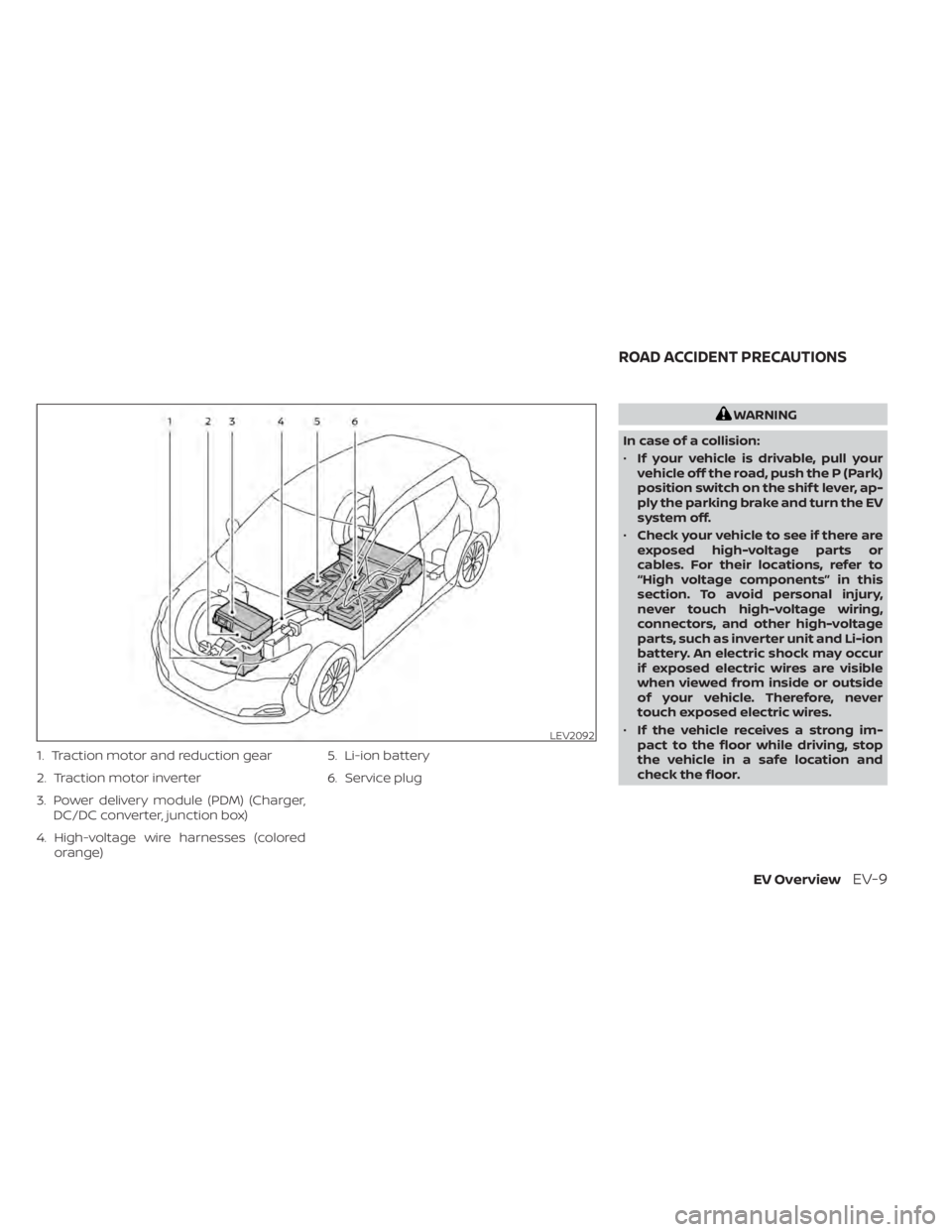
1. Traction motor and reduction gear
2. Traction motor inverter
3. Power delivery module (PDM) (Charger,DC/DC converter, junction box)
4. High-voltage wire harnesses (colored orange) 5. Li-ion battery
6. Service plug
WARNING
In case of a collision:
• If your vehicle is drivable, pull your
vehicle off the road, push the P (Park)
position switch on the shif t lever, ap-
ply the parking brake and turn the EV
system off.
• Check your vehicle to see if there are
exposed high-voltage parts or
cables. For their locations, refer to
“High voltage components” in this
section. To avoid personal injury,
never touch high-voltage wiring,
connectors, and other high-voltage
parts, such as inverter unit and Li-ion
battery. An electric shock may occur
if exposed electric wires are visible
when viewed from inside or outside
of your vehicle. Therefore, never
touch exposed electric wires.
• If the vehicle receives a strong im-
pact to the floor while driving, stop
the vehicle in a safe location and
check the floor.
LEV2092
ROAD ACCIDENT PRECAUTIONS
EV OverviewEV-9
Page 44 of 596
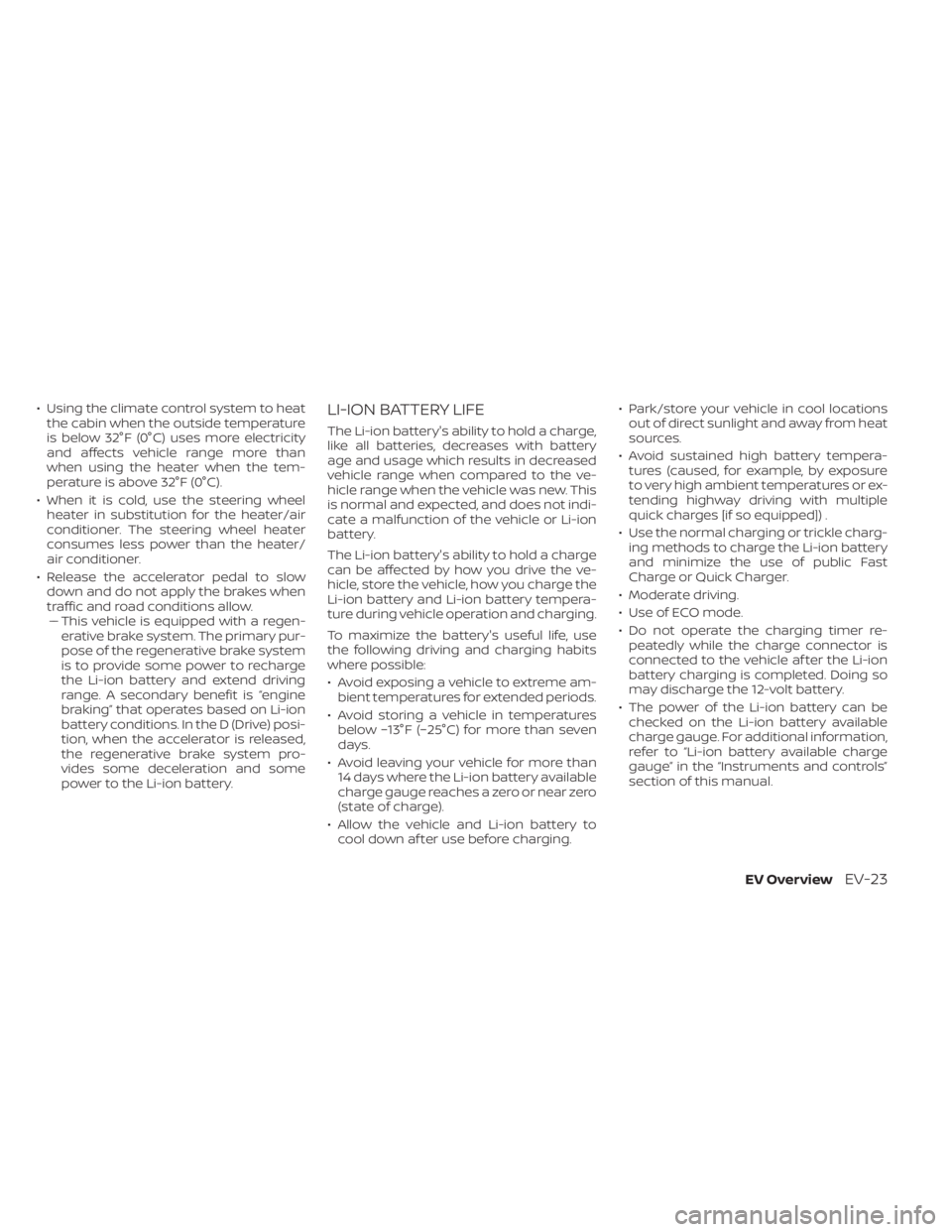
• Using the climate control system to heatthe cabin when the outside temperature
is below 32°F (0°C) uses more electricity
and affects vehicle range more than
when using the heater when the tem-
perature is above 32°F (0°C).
• When it is cold, use the steering wheel heater in substitution for the heater/air
conditioner. The steering wheel heater
consumes less power than the heater/
air conditioner.
• Release the accelerator pedal to slow down and do not apply the brakes when
traffic and road conditions allow.– – This vehicle is equipped with a regen-
erative brake system. The primary pur-
pose of the regenerative brake system
is to provide some power to recharge
the Li-ion battery and extend driving
range. A secondary benefit is “engine
braking” that operates based on Li-ion
battery conditions. In the D (Drive) posi-
tion, when the accelerator is released,
the regenerative brake system pro-
vides some deceleration and some
power to the Li-ion battery.LI-ION BATTERY LIFE
The Li-ion battery's ability to hold a charge,
like all batteries, decreases with battery
age and usage which results in decreased
vehicle range when compared to the ve-
hicle range when the vehicle was new. This
is normal and expected, and does not indi-
cate a malfunction of the vehicle or Li-ion
battery.
The Li-ion battery's ability to hold a charge
can be affected by how you drive the ve-
hicle, store the vehicle, how you charge the
Li-ion battery and Li-ion battery tempera-
ture during vehicle operation and charging.
To maximize the battery's useful life, use
the following driving and charging habits
where possible:
• Avoid exposing a vehicle to extreme am- bient temperatures for extended periods.
• Avoid storing a vehicle in temperatures below −13°F (−25°C) for more than seven
days.
• Avoid leaving your vehicle for more than 14 days where the Li-ion battery available
charge gauge reaches a zero or near zero
(state of charge).
• Allow the vehicle and Li-ion battery to cool down af ter use before charging. • Park/store your vehicle in cool locations
out of direct sunlight and away from heat
sources.
• Avoid sustained high battery tempera- tures (caused, for example, by exposure
to very high ambient temperatures or ex-
tending highway driving with multiple
quick charges [if so equipped]) .
• Use the normal charging or trickle charg- ing methods to charge the Li-ion battery
and minimize the use of public Fast
Charge or Quick Charger.
• Moderate driving.
• Use of ECO mode.
• Do not operate the charging timer re- peatedly while the charge connector is
connected to the vehicle af ter the Li-ion
battery charging is completed. Doing so
may discharge the 12-volt battery.
• The power of the Li-ion battery can be checked on the Li-ion battery available
charge gauge. For additional information,
refer to “Li-ion battery available charge
gauge” in the “Instruments and controls”
section of this manual.
EV OverviewEV-23
Page 52 of 596
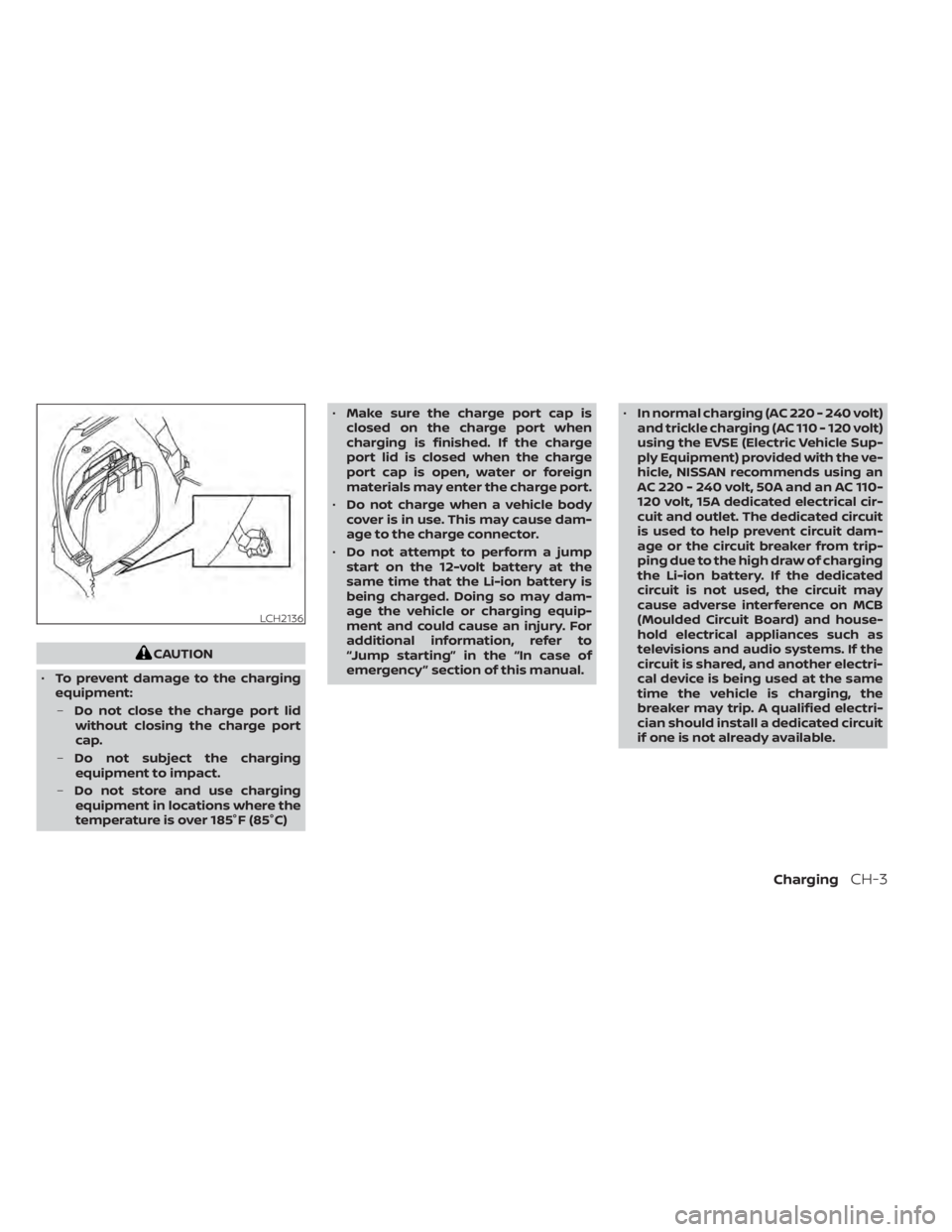
CAUTION
• To prevent damage to the charging
equipment:
– Do not close the charge port lid
without closing the charge port
cap.
– Do not subject the charging
equipment to impact.
– Do not store and use charging
equipment in locations where the
temperature is over 185°F (85°C) •
Make sure the charge port cap is
closed on the charge port when
charging is finished. If the charge
port lid is closed when the charge
port cap is open, water or foreign
materials may enter the charge port.
• Do not charge when a vehicle body
cover is in use. This may cause dam-
age to the charge connector.
• Do not attempt to perform a jump
start on the 12-volt battery at the
same time that the Li-ion battery is
being charged. Doing so may dam-
age the vehicle or charging equip-
ment and could cause an injury. For
additional information, refer to
“Jump starting” in the “In case of
emergency ” section of this manual. •
In normal charging (AC 220 - 240 volt)
and trickle charging (AC 110 - 120 volt)
using the EVSE (Electric Vehicle Sup-
ply Equipment) provided with the ve-
hicle, NISSAN recommends using an
AC 220 - 240 volt, 50A and an AC 110-
120 volt, 15A dedicated electrical cir-
cuit and outlet. The dedicated circuit
is used to help prevent circuit dam-
age or the circuit breaker from trip-
ping due to the high draw of charging
the Li-ion battery. If the dedicated
circuit is not used, the circuit may
cause adverse interference on MCB
(Moulded Circuit Board) and house-
hold electrical appliances such as
televisions and audio systems. If the
circuit is shared, and another electri-
cal device is being used at the same
time the vehicle is charging, the
breaker may trip. A qualified electri-
cian should install a dedicated circuit
if one is not already available.
LCH2136
ChargingCH-3
Page 56 of 596
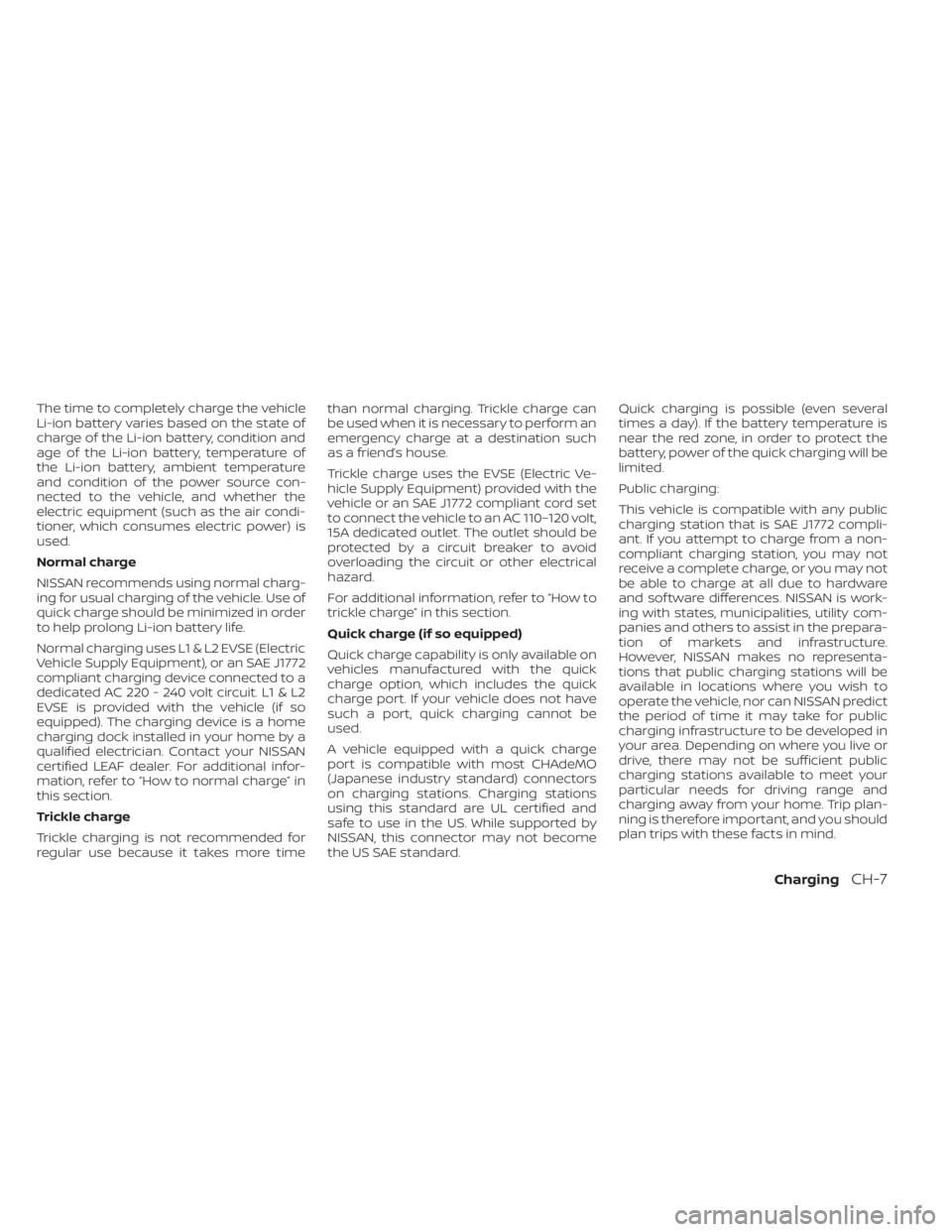
The time to completely charge the vehicle
Li-ion battery varies based on the state of
charge of the Li-ion battery, condition and
age of the Li-ion battery, temperature of
the Li-ion battery, ambient temperature
and condition of the power source con-
nected to the vehicle, and whether the
electric equipment (such as the air condi-
tioner, which consumes electric power) is
used.
Normal charge
NISSAN recommends using normal charg-
ing for usual charging of the vehicle. Use of
quick charge should be minimized in order
to help prolong Li-ion battery life.
Normal charging uses L1 & L2 EVSE (Electric
Vehicle Supply Equipment), or an SAE J1772
compliant charging device connected to a
dedicated AC 220 - 240 volt circuit. L1 & L2
EVSE is provided with the vehicle (if so
equipped). The charging device is a home
charging dock installed in your home by a
qualified electrician. Contact your NISSAN
certified LEAF dealer. For additional infor-
mation, refer to “How to normal charge” in
this section.
Trickle charge
Trickle charging is not recommended for
regular use because it takes more timethan normal charging. Trickle charge can
be used when it is necessary to perform an
emergency charge at a destination such
as a friend’s house.
Trickle charge uses the EVSE (Electric Ve-
hicle Supply Equipment) provided with the
vehicle or an SAE J1772 compliant cord set
to connect the vehicle to an AC 110–120 volt,
15A dedicated outlet. The outlet should be
protected by a circuit breaker to avoid
overloading the circuit or other electrical
hazard.
For additional information, refer to “How to
trickle charge” in this section.
Quick charge (if so equipped)
Quick charge capability is only available on
vehicles manufactured with the quick
charge option, which includes the quick
charge port. If your vehicle does not have
such a port, quick charging cannot be
used.
A vehicle equipped with a quick charge
port is compatible with most CHAdeMO
(Japanese industry standard) connectors
on charging stations. Charging stations
using this standard are UL certified and
safe to use in the US. While supported by
NISSAN, this connector may not become
the US SAE standard.Quick charging is possible (even several
times a day). If the battery temperature is
near the red zone, in order to protect the
battery, power of the quick charging will be
limited.
Public charging:
This vehicle is compatible with any public
charging station that is SAE J1772 compli-
ant. If you attempt to charge from a non-
compliant charging station, you may not
receive a complete charge, or you may not
be able to charge at all due to hardware
and sof tware differences. NISSAN is work-
ing with states, municipalities, utility com-
panies and others to assist in the prepara-
tion of markets and infrastructure.
However, NISSAN makes no representa-
tions that public charging stations will be
available in locations where you wish to
operate the vehicle, nor can NISSAN predict
the period of time it may take for public
charging infrastructure to be developed in
your area. Depending on where you live or
drive, there may not be sufficient public
charging stations available to meet your
particular needs for driving range and
charging away from your home. Trip plan-
ning is therefore important, and you should
plan trips with these facts in mind.
ChargingCH-7
Page 57 of 596
![NISSAN LEAF 2020 Owner´s Manual Quick charge uses public charging sta-
tions (up to 50 kW of power [for 40 kWh
battery models] / 100 kW of power [for 62
kWh battery models]).
The time needed to charge the Li-ion bat-
tery from disch NISSAN LEAF 2020 Owner´s Manual Quick charge uses public charging sta-
tions (up to 50 kW of power [for 40 kWh
battery models] / 100 kW of power [for 62
kWh battery models]).
The time needed to charge the Li-ion bat-
tery from disch](/img/5/40305/w960_40305-56.png)
Quick charge uses public charging sta-
tions (up to 50 kW of power [for 40 kWh
battery models] / 100 kW of power [for 62
kWh battery models]).
The time needed to charge the Li-ion bat-
tery from discharged (low battery charge
indicator light illuminated) to 80% charged
using the quick charger depends on many
factors including the Li-ion battery tem-
perature and the type of quick charger
used.
It may take more time to charge the Li-ion
battery using the quick charger if the ve-
hicle is parked in a cold location for a long
time.
It may take more time to charge the Li-ion
battery using the quick charger if the tem-
perature of the Li-ion battery is high or low.
The Li-ion battery temperature gauge can
be used to estimate the approximate time
needed to charge the Li-ion battery to 80%.
If charging stops mid-charge, you can re-
start charging by pressing the start button
on the quick charger station again. Quick
charging is possible (even several times a
day). If the battery temperature is near the
red zone, in order to protect the battery,
power of the quick charging will be limited.V2X charge/discharge (if so equipped)
V2X charge/discharge capability is only
available on vehicles manufactured with
the V2X charge/discharge option, which in-
cludes the quick charge port.
A vehicle equipped with a quick charge
port is compatible with most CHAdeMO
(Japanese industry standard) connectors
on charging stations.
Charging stations or V2X charging/
discharging devices using this standard
are UL certified and safe to use in the US.
While supported by NISSAN, this connector
may not become the US SAE standard. V2X
charging/discharging is possible (even
several times a day). If the battery tempera-
ture is near the red zone, in order to protect
the battery, power of the V2X charging/
discharging will be limited.
For additional information, consult a V2X
device manufacturer or a V2X charging/
discharging service provider.
LHA5087
For 40 kWh battery models
LHA5184
For 62 kWh battery models*
*Subject to charging equipment capability to output 100kW
CH-8Charging
Page 188 of 596
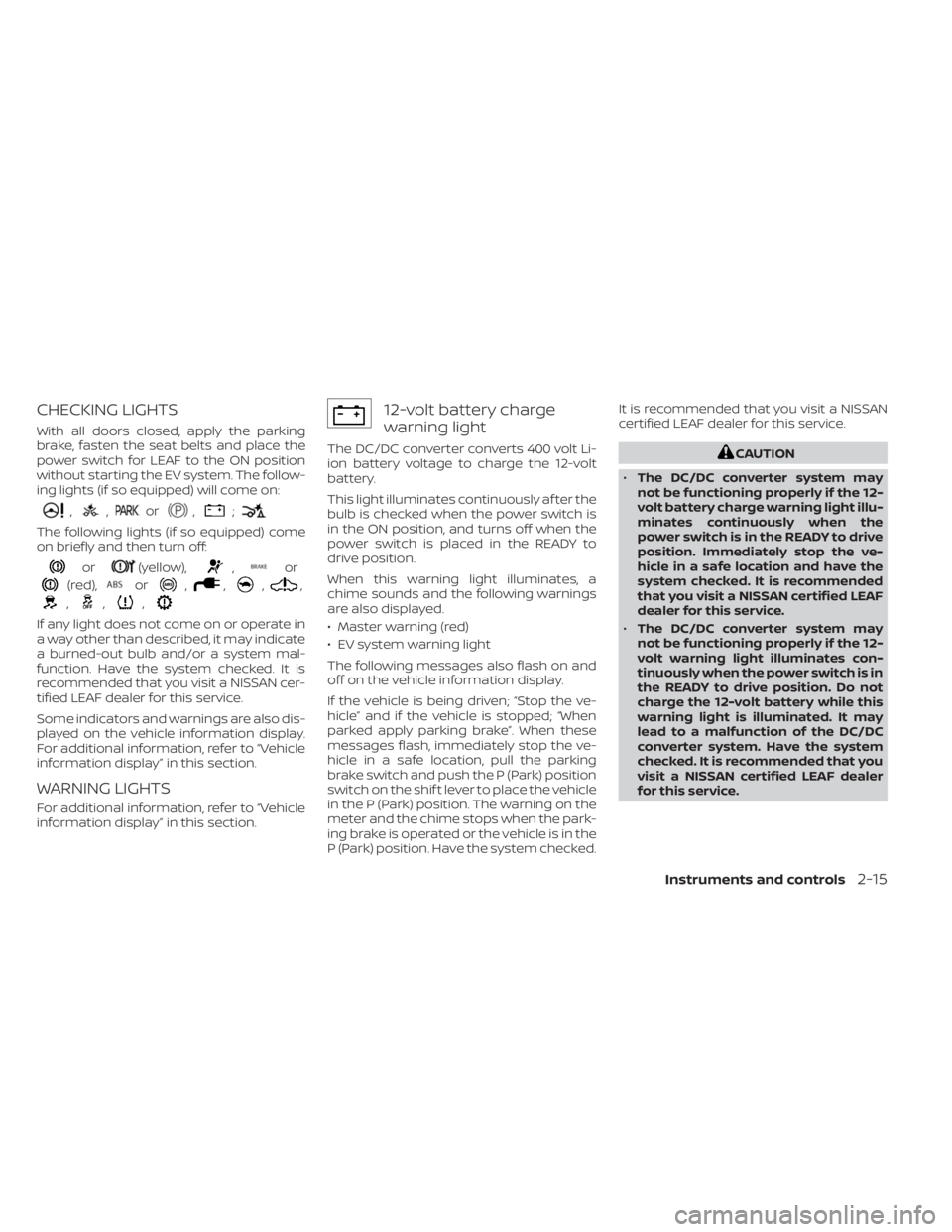
CHECKING LIGHTS
With all doors closed, apply the parking
brake, fasten the seat belts and place the
power switch for LEAF to the ON position
without starting the EV system. The follow-
ing lights (if so equipped) will come on:
,,or,;
The following lights (if so equipped) come
on briefly and then turn off:
or(yellow),,or
(red),or,,,,
,,,
If any light does not come on or operate in
a way other than described, it may indicate
a burned-out bulb and/or a system mal-
function. Have the system checked. It is
recommended that you visit a NISSAN cer-
tified LEAF dealer for this service.
Some indicators and warnings are also dis-
played on the vehicle information display.
For additional information, refer to “Vehicle
information display” in this section.
WARNING LIGHTS
For additional information, refer to “Vehicle
information display” in this section.
12-volt battery charge
warning light
The DC/DC converter converts 400 volt Li-
ion battery voltage to charge the 12-volt
battery.
This light illuminates continuously af ter the
bulb is checked when the power switch is
in the ON position, and turns off when the
power switch is placed in the READY to
drive position.
When this warning light illuminates, a
chime sounds and the following warnings
are also displayed.
• Master warning (red)
• EV system warning light
The following messages also flash on and
off on the vehicle information display.
If the vehicle is being driven; “Stop the ve-
hicle” and if the vehicle is stopped; “When
parked apply parking brake”. When these
messages flash, immediately stop the ve-
hicle in a safe location, pull the parking
brake switch and push the P (Park) position
switch on the shif t lever to place the vehicle
in the P (Park) position. The warning on the
meter and the chime stops when the park-
ing brake is operated or the vehicle is in the
P (Park) position. Have the system checked.It is recommended that you visit a NISSAN
certified LEAF dealer for this service.CAUTION
• The DC/DC converter system may
not be functioning properly if the 12-
volt battery charge warning light illu-
minates continuously when the
power switch is in the READY to drive
position. Immediately stop the ve-
hicle in a safe location and have the
system checked. It is recommended
that you visit a NISSAN certified LEAF
dealer for this service.
• The DC/DC converter system may
not be functioning properly if the 12-
volt warning light illuminates con-
tinuously when the power switch is in
the READY to drive position. Do not
charge the 12-volt battery while this
warning light is illuminated. It may
lead to a malfunction of the DC/DC
converter system. Have the system
checked. It is recommended that you
visit a NISSAN certified LEAF dealer
for this service.
Instruments and controls2-15
Page 196 of 596
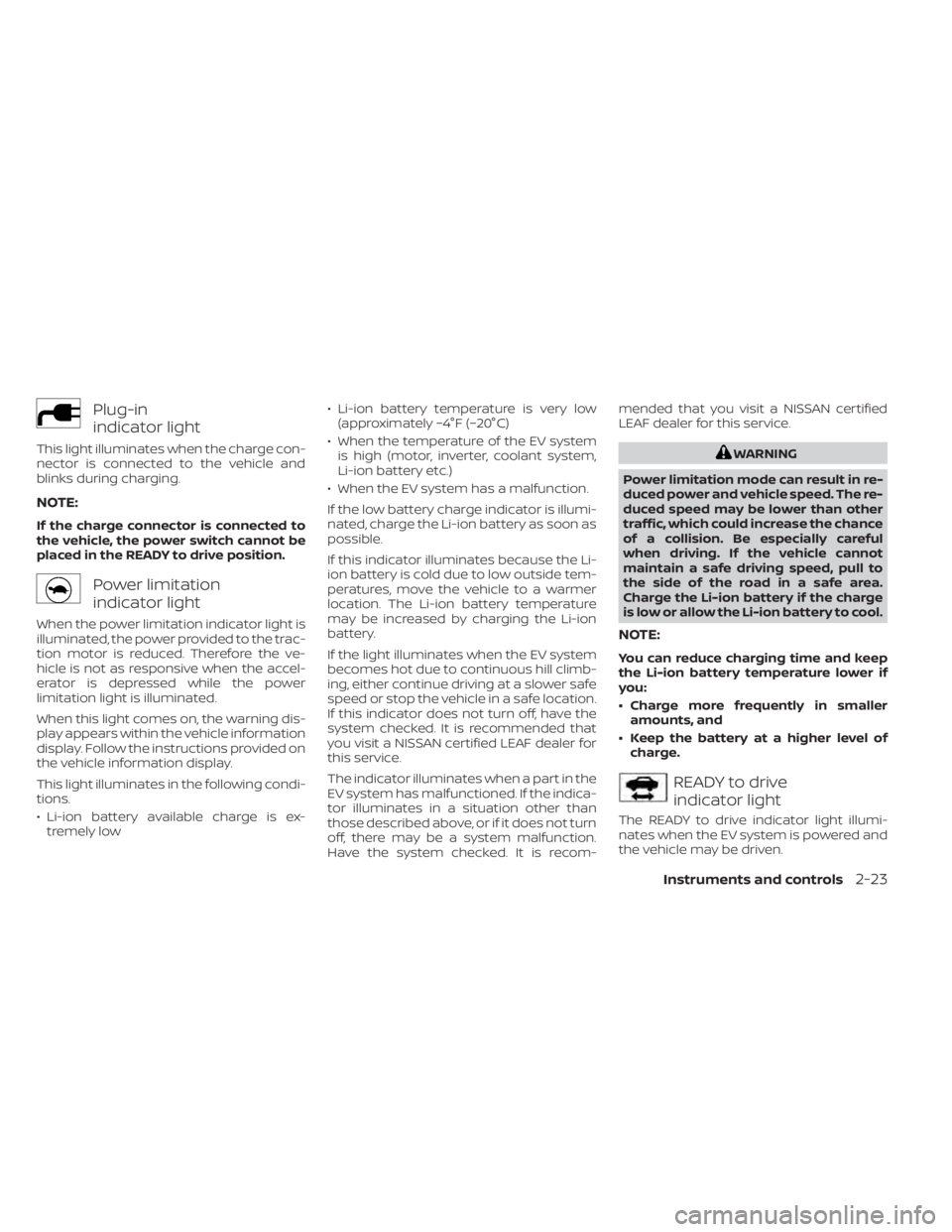
Plug-in
indicator light
This light illuminates when the charge con-
nector is connected to the vehicle and
blinks during charging.
NOTE:
If the charge connector is connected to
the vehicle, the power switch cannot be
placed in the READY to drive position.
Power limitation
indicator light
When the power limitation indicator light is
illuminated, the power provided to the trac-
tion motor is reduced. Therefore the ve-
hicle is not as responsive when the accel-
erator is depressed while the power
limitation light is illuminated.
When this light comes on, the warning dis-
play appears within the vehicle information
display. Follow the instructions provided on
the vehicle information display.
This light illuminates in the following condi-
tions.
• Li-ion battery available charge is ex-tremely low • Li-ion battery temperature is very low
(approximately −4°F (−20°C)
• When the temperature of the EV system is high (motor, inverter, coolant system,
Li-ion battery etc.)
• When the EV system has a malfunction.
If the low battery charge indicator is illumi-
nated, charge the Li-ion battery as soon as
possible.
If this indicator illuminates because the Li-
ion battery is cold due to low outside tem-
peratures, move the vehicle to a warmer
location. The Li-ion battery temperature
may be increased by charging the Li-ion
battery.
If the light illuminates when the EV system
becomes hot due to continuous hill climb-
ing, either continue driving at a slower safe
speed or stop the vehicle in a safe location.
If this indicator does not turn off, have the
system checked. It is recommended that
you visit a NISSAN certified LEAF dealer for
this service.
The indicator illuminates when a part in the
EV system has malfunctioned. If the indica-
tor illuminates in a situation other than
those described above, or if it does not turn
off, there may be a system malfunction.
Have the system checked. It is recom- mended that you visit a NISSAN certified
LEAF dealer for this service.
WARNING
Power limitation mode can result in re-
duced power and vehicle speed. The re-
duced speed may be lower than other
traffic, which could increase the chance
of a collision. Be especially careful
when driving. If the vehicle cannot
maintain a safe driving speed, pull to
the side of the road in a safe area.
Charge the Li-ion battery if the charge
is low or allow the Li-ion battery to cool.
NOTE:
You can reduce charging time and keep
the Li-ion battery temperature lower if
you:
• Charge more frequently in smaller amounts, and
• Keep the battery at a higher level of charge.
READY to drive
indicator light
The READY to drive indicator light illumi-
nates when the EV system is powered and
the vehicle may be driven.
Instruments and controls2-23
Page 198 of 596
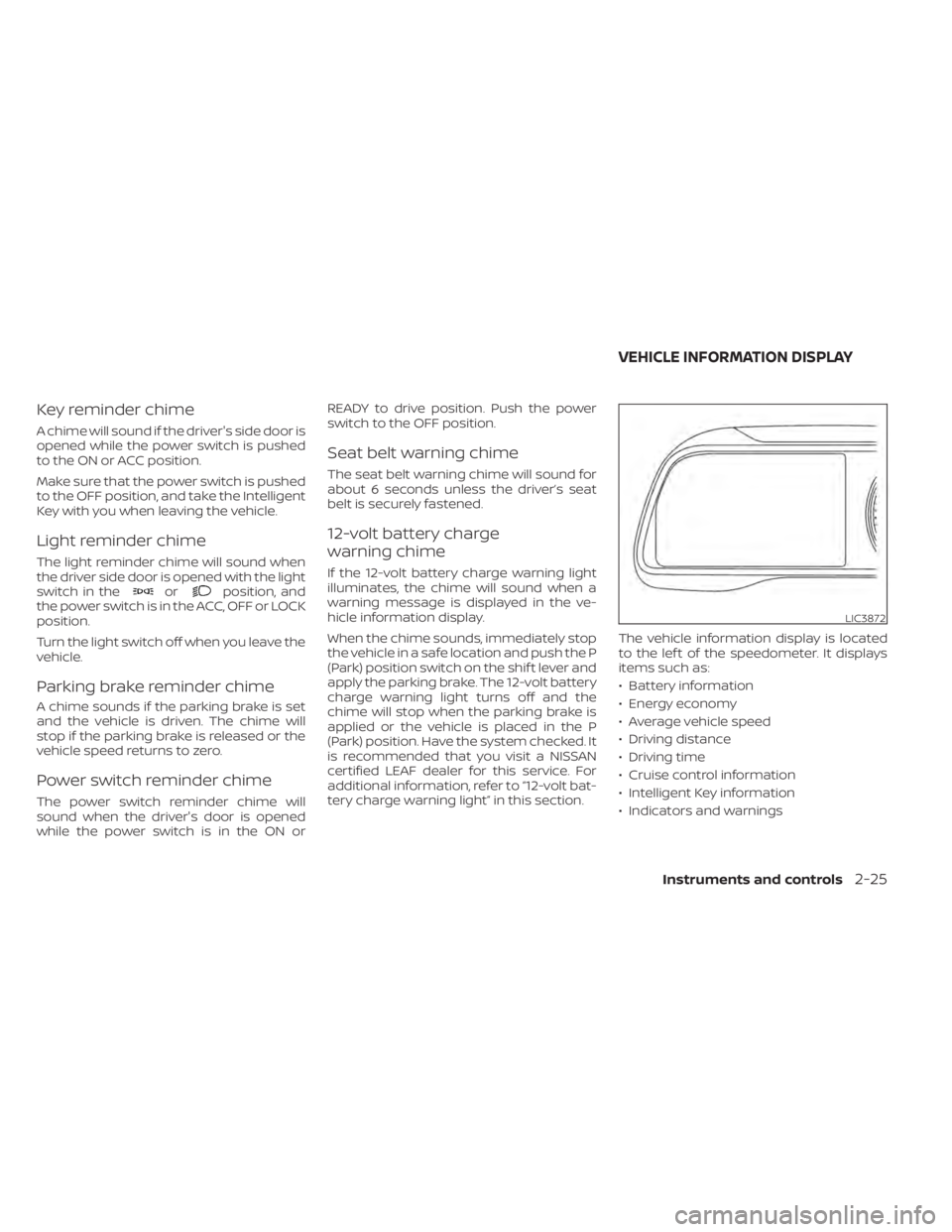
Key reminder chime
A chime will sound if the driver's side door is
opened while the power switch is pushed
to the ON or ACC position.
Make sure that the power switch is pushed
to the OFF position, and take the Intelligent
Key with you when leaving the vehicle.
Light reminder chime
The light reminder chime will sound when
the driver side door is opened with the light
switch in the
orposition, and
the power switch is in the ACC, OFF or LOCK
position.
Turn the light switch off when you leave the
vehicle.
Parking brake reminder chime
A chime sounds if the parking brake is set
and the vehicle is driven. The chime will
stop if the parking brake is released or the
vehicle speed returns to zero.
Power switch reminder chime
The power switch reminder chime will
sound when the driver's door is opened
while the power switch is in the ON or READY to drive position. Push the power
switch to the OFF position.
Seat belt warning chime
The seat belt warning chime will sound for
about 6 seconds unless the driver’s seat
belt is securely fastened.
12-volt battery charge
warning chime
If the 12-volt battery charge warning light
illuminates, the chime will sound when a
warning message is displayed in the ve-
hicle information display.
When the chime sounds, immediately stop
the vehicle in a safe location and push the P
(Park) position switch on the shif t lever and
apply the parking brake. The 12-volt battery
charge warning light turns off and the
chime will stop when the parking brake is
applied or the vehicle is placed in the P
(Park) position. Have the system checked. It
is recommended that you visit a NISSAN
certified LEAF dealer for this service. For
additional information, refer to “12-volt bat-
tery charge warning light” in this section.
The vehicle information display is located
to the lef t of the speedometer. It displays
items such as:
• Battery information
• Energy economy
• Average vehicle speed
• Driving distance
• Driving time
• Cruise control information
• Intelligent Key information
• Indicators and warnings
LIC3872
VEHICLE INFORMATION DISPLAY
Instruments and controls2-25